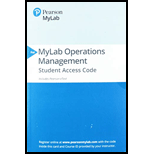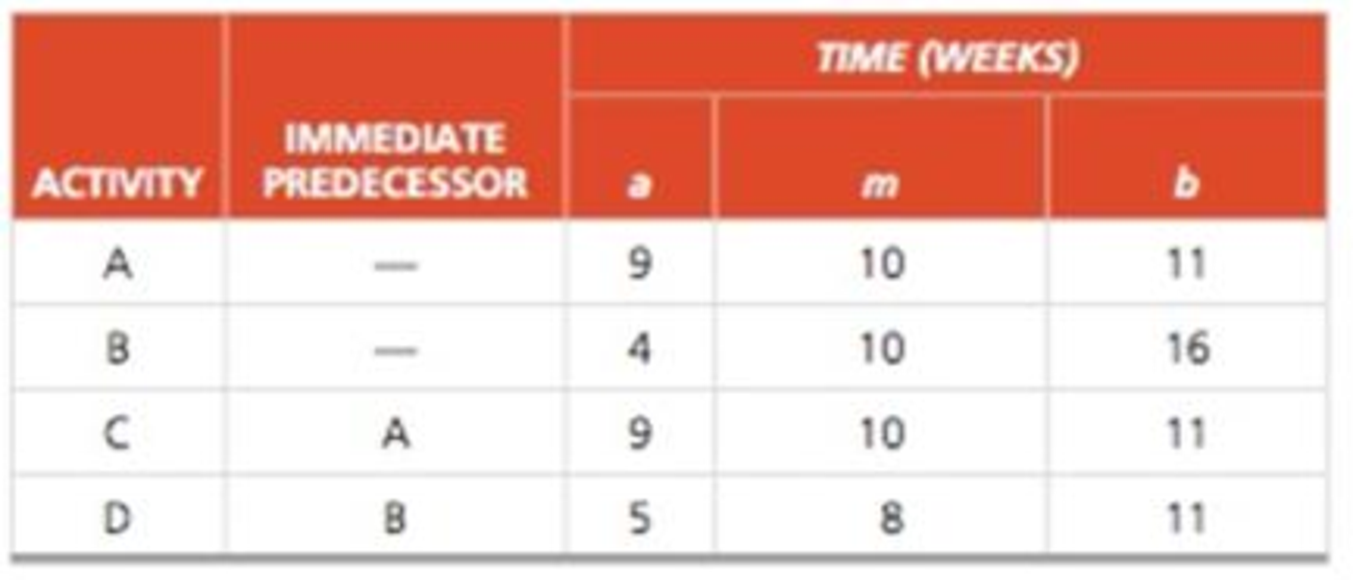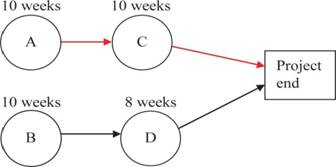
Concept explainers
The estimated times and immediate predecessors for the activities in a project at George Kyparis’s retinal scanning company are given in the following table. Assume that the activity times are independent.

a) Calculate the expected time and variance for each activity.
b) What is the expected completion time of the critical path? What is the expected completion time of the other path in the network?
c) What is the variance of the critical path? What is the variance of the other path in the network?
d) If the time to complete path A–C is
e) If the time to complete path B–D is normally distributed, what is the probability that this path will be finished in 22 weeks or less?
f) Explain why the probability that the critical path will be finished in 22 weeks or less is not necessarily the probability that the project will be finished in 22 weeks or less.
a)
To determine: The expected time and variance.
Introduction:
The activity times of various tasks in a PERT project network are assumed to follow a probability distribution. For calculating the expected times and standard deviation, the parameters required are the following:
- Optimistic time: This is the time denoted by “a”, which is the best possible or in other words, the quickest time in which an activity can be completed, assuming that everything goes as per plan.
- Pessimistic time: This is the worst case scenario, where all the conditions are adverse or unfavorable. The maximum time which may be taken in such a situation is the pessimistic time denoted by “b”.
- Most likely time: The most realistic estimate of the time, denoted by “m” in normal conditions, is another parameter which is important in the computation of expected times and variances.
Answer to Problem 20P
The expected times and varianceare shown in Table 1.
Explanation of Solution
Given information:
| Activity | Immediate predecessor | Time in weeks | ||
| a | m | b | ||
| A | 9 | 10 | 11 | |
| B | 4 | 10 | 16 | |
| C | A | 9 | 10 | 11 |
| D | B | 5 | 8 | 11 |
Formula:
Calculate the expected time t and the variances for each activity by using the equations
where ‘a’ is the optimistic time, ‘m’ is the most likely time and ‘b’ is the most pessimistic time.
Calculation of expected time and variance:
The calculations are shown below.
| Activity | Immediate predecessor | Time in weeks | t | Variance | ||
| a | m | b | ||||
| A | 9 | 10 | 11 | 10 | 0.11 | |
| B | 4 | 10 | 16 | 10 | 4 | |
| C | A | 9 | 10 | 11 | 10 | 0.11 |
| D | B | 5 | 8 | 11 | 8 | 1 |
Table 1
Excel worksheet:

Hence, the expected times and variance are shown in Table 1.
b)
To determine: The expected completion of critical path and other path (non-ciritical paths).
Answer to Problem 20P
The critical path is AàC and its expected completion time is 20 weeks. The expected completion time of the other path BàD is 18 weeks.
Explanation of Solution
Given information:
| Activity | Immediate predecessor | Time in weeks | ||
| a | m | b | ||
| A | 9 | 10 | 11 | |
| B | 4 | 10 | 16 | |
| C | A | 9 | 10 | 11 |
| D | B | 5 | 8 | 11 |
Calculation of expected completion of critical path and other path (non-ciritical paths):
AON diagram is constructed which is shown below.

The critical path is AàC and expected completion time is 20 weeks. The expected completion time of the other path BàD is 18 weeks.
Hence, the critical path is AàC and its expected completion time is 20 weeks. The expected completion time of the other path BàD is 18 weeks.
c)
To determine: The variance of critical path and other path (non-ciritical paths).
Answer to Problem 20P
The variance of the critical path AàC is 0.222 weeks and other path BàD is5 weeks.
Explanation of Solution
Given information:
| Activity | Immediate predecessor | Time in weeks | ||
| a | m | b | ||
| A | 9 | 10 | 11 | |
| B | 4 | 10 | 16 | |
| C | A | 9 | 10 | 11 |
| D | B | 5 | 8 | 11 |
Calculation of variance of critical path and other path:
The variance of the critical path AàC is the sum of the variances of activities A and C.
The variance of the critical path is the sum of 0.1111 and 0.1111 (refer table 1) which is 0.2222 weeks.
The variance of the other path BàD is the sum of the variances of activities B and D.
The variance of the other path is the sum of 4 and 1 (refer table 1) which is 5 weeksThe variance of the other path BàD is 5 weeks.
Hence, the variance of the critical path AàC is 0.222 weeks and other path BàD is 5 weeks.
d)
To determine: The probability of finishing the project in 22 weeks, when A-C is normally distributed.
Answer to Problem 20P
Probability of finishing the project in 22 weeks is almost 1.
Explanation of Solution
Given information:
| Activity | Immediate predecessor | Time in weeks | ||
| a | m | b | ||
| A | 9 | 10 | 11 | |
| B | 4 | 10 | 16 | |
| C | A | 9 | 10 | 11 |
| D | B | 5 | 8 | 11 |
Probability of finishing the project in 22 weeks, when A-C is normally distributed:
The expected completion time of critical path AàC is 20 weeks with a variance of 0.22 weeks.
The standard deviation:
The standard deviation is calculated by taking square root of the variance which is 0.22 which yields 0.469.
Z value is calculated by dividing the difference of 22 and 20 with 0.469 which yields 4.264.
Reading from normal distribution tables given the mean is 20 weeks, the variance
Hence, probability of finishing the project in 22 weeks is almost 1.
e)
To determine: The probability of finishing the project in 22 weeks, when B-D is normally distributed.
Answer to Problem 20P
Probability of finishing the project in 22 weeks is 0.963.
Explanation of Solution
Given information:
| Activity | Immediate predecessor | Time in weeks | ||
| a | m | b | ||
| A | 9 | 10 | 11 | |
| B | 4 | 10 | 16 | |
| C | A | 9 | 10 | 11 |
| D | B | 5 | 8 | 11 |
Probability of finishing the project in 22 weeks, when B-D is normally distributed:
The expected completion time of path BàD is 18 weeks with a variance of 5 weeks.
The standard deviation:
The standard deviation is calculated by taking square root of the variance which is 5 which yields 2.236.
Z value is calculated by dividing the difference of 22 and 18 with 2.236 which yields 1.79.
Reading from normal distribution tables given the mean is 18 weeks, the variance
Hence, the probability of finishing the project in 22 weeks is 0.963.
f)
To explain: The reason for the probability that the critical path will be finished in 22 weeks or less is not necessarily the probability that the project will be finished in 22 weeks or less.
Explanation of Solution
Given information:
| Activity | Immediate predecessor | Time in weeks | ||
| a | m | b | ||
| A | 9 | 10 | 11 | |
| B | 4 | 10 | 16 | |
| C | A | 9 | 10 | 11 |
| D | B | 5 | 8 | 11 |
Explanation for the reason for the probability that the critical path will be finished in 22 weeks or less is not necessarily the probability that the project will be finished in 22 weeks or less:
The critical path AàC has a very small variance of only 0.22 weeks compared to the variance along path BàD which is 5 weeks. That is why, despite having lower expected time of completion of 18 weeks, the probability that the path BàD would be completed in 22 weeks is0.963.and is lower than the probability
The project is completed only when all the activities are completed.
Despite the probability of the critical path AàC, being completed in 22 weeks being almost 1, the probability that the project is completed in 22 weeks is0.963.
Want to see more full solutions like this?
Chapter 3 Solutions
EBK PRINCIPLES OF OPERATIONS MANAGEMENT
- PepsiCo South Africa says the incident where a woman discovered part of a rodent in her loaf of bread, is anisolated occurrence.Durban woman, Nombulelo Mkumla, took to social media last week to share how she discovered the rodent.In a lengthy Facebook post, she said she purchased the loaf of bread from a local shop after work on August 27.For the next days, Mkumla proceeded to use slices of bread from the load to make toast."Then, on the morning of August 31, I took the bread out of the fridge to make toast and noticed something disgusting andscary. I took a picture and sent it to my friends, and one of them said, 'Yi mpuku leyo tshomi' [That's a rat friend]“."I was in denial and suggested it might be something else, but the rat scenario made sense - it's possible the rat got into thebread at the factory, and no one noticed," Mkumla said.She went back to the shop she'd bought the bread from and was told to lay a complaint directly with the supplier.She sent an email with a video and…arrow_forwardThe deaths are included in the discharges; this includes deaths occurring in less than 48 hours and postoperative deaths. Rehabilitation had 362 discharges, 22 deaths, 1<48 hours, 0 Postoperative. what is the gross death rate for the rehabilitation service?arrow_forwardA copy machine is available 24 hours a day. On a typical day, the machine produces 100 jobs. Each job takes about 3 minutes on the machine, 2 minutes of which is processing time and 1 minute is setup time (logging in, defining the job). About 20 percent of the jobs need to be reworked, in which case the setup time and the processing time have to be repeated. The remainder of the time, the equipment is idle. What is the OEE of the equipment?arrow_forward
- How do you think we can keep updating Toyota's ideas as new technologies come out and what customers want keeps changing?arrow_forwardGiven how TPS has helped change things in so many fields, do you think there are parts of it that might be hard to use in areas that aren’t about making things, like in healthcare or services? If so, why do you think that might be?arrow_forwardDo you feel there is anything positive about rework?arrow_forward
- Do you think technology can achieve faster setup times? How would it be implemented in the hospital workforce?arrow_forwardIn your experience or opinion, do you think process changes like organizing workspaces make a bigger difference, or is investing in technology usually the better solution for faster setups?arrow_forwardHave you seen rework done in your business, and what was done to prevent that from occurring again?arrow_forward
- Research a company different than case studies examined and search the internet and find an example of a business that had to rework a process. How was the organization affected to rework a process in order to restore a good flow unit? Did rework hurt a process or improve the organization's operational efficiency? • Note: Include a reference with supportive citations in the discussion reply in your post.arrow_forwardSetup time is very important in affecting a process and the capacity of a process. How do you reduce setup time? Give examples of reducing setup time. Please Provide a referenecearrow_forwardDo you think TPS was successful? If so, how? Are there other companies that have used TPS? If so, give examples. Please provide a referencearrow_forward
 Practical Management ScienceOperations ManagementISBN:9781337406659Author:WINSTON, Wayne L.Publisher:Cengage,
Practical Management ScienceOperations ManagementISBN:9781337406659Author:WINSTON, Wayne L.Publisher:Cengage,

